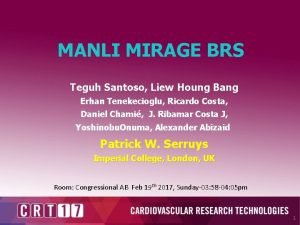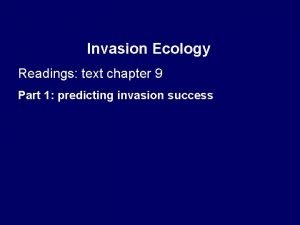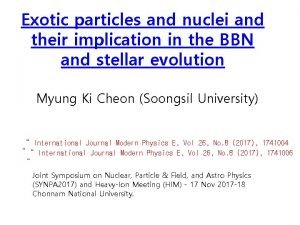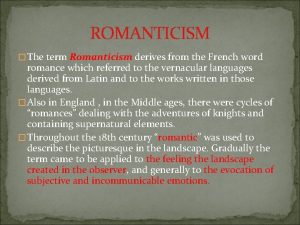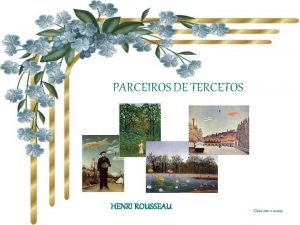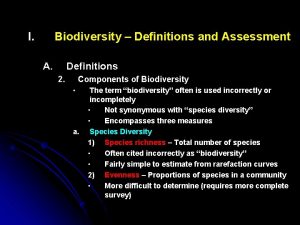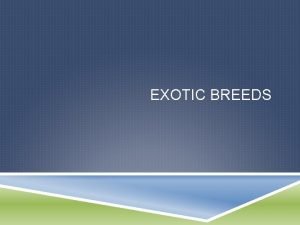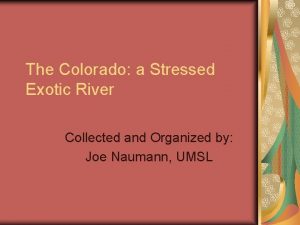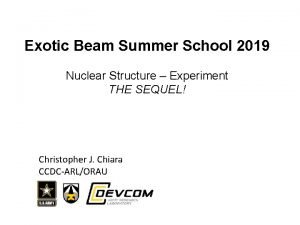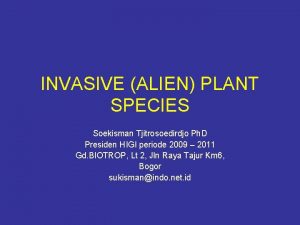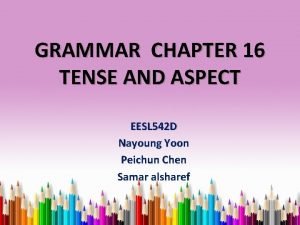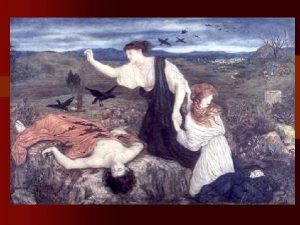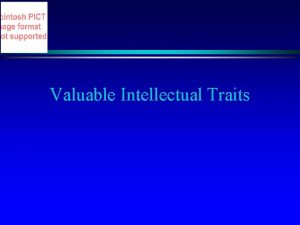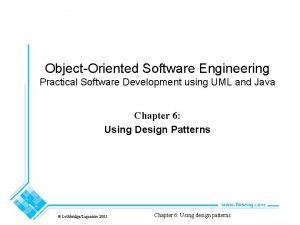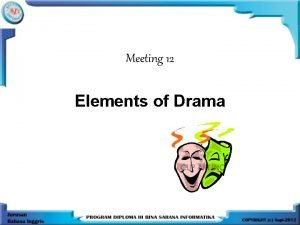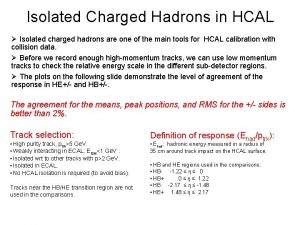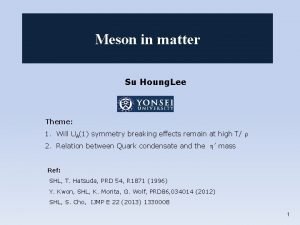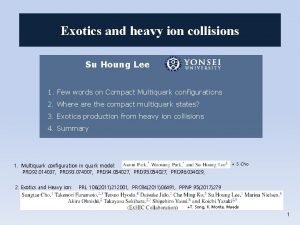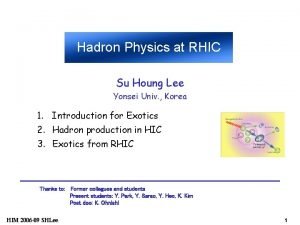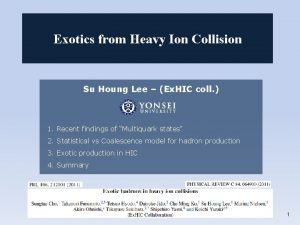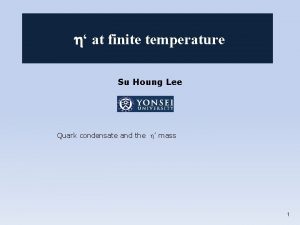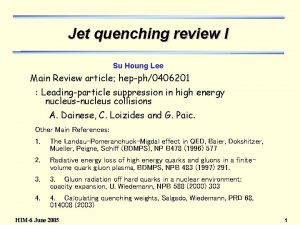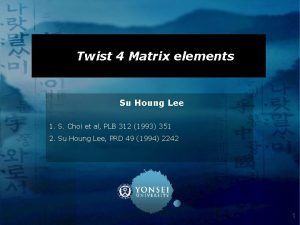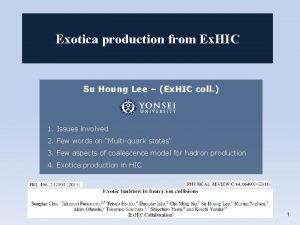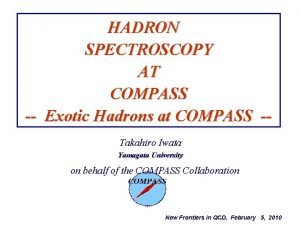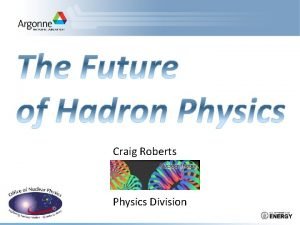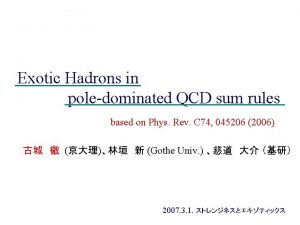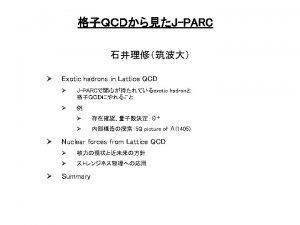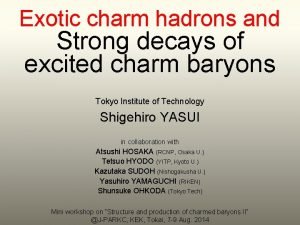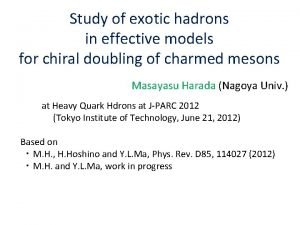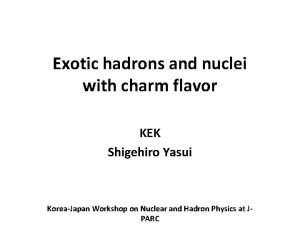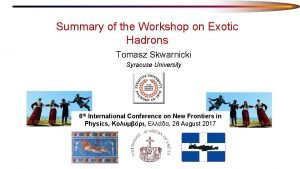Theoretical aspects of exotic hadrons Su Houng Lee



























- Slides: 27

Theoretical aspects of exotic hadrons Su Houng Lee 1. Few words on hadronic molecule candidates 2. Few words on diquarks and heavy Multiquark States 3. Summary of disucssions 1

Recent Highlights in Hadron Physics – Heavy quark sector Babar: DSJ(2317) 0+ Puzzle in Constituent Quark Model(2400) 1. D 0 K+ (2358) threshold effect 2. Chiral partner of (0 - 1 -) 3. Tetraquark molecule ? D 0 D* D 1 1864 2007 2420 D 0+D* D*+D* D+D 1 D 1+D* 3871 4014 4284 4427 X(3872) , Y(4260), Z(4430) y’p Z(4051), Z(4248) cc 1 p Must contain cc ? 2

Previous Work on Multiquark hadrons - Light quark sector Scalar tetraquark (Jaffe 76) L(1405) (Jido, Sekihara. . ) N Search for H dibaryon K + S p Search for Q+ pentaquark 3

New perspectives on hadron physics from RHIC Ø large number of c , b quark production Ø Vertex detector: Ø Larger source size: A. Ohnishi. . particle correlation H LL weakly decaying exotics f 0 a 0 K+ K- Ds 0 D 0 K+ X(3872) D 0* L(1405) P K- 4

Some insights from for Multiquark configurations in a schematic quark model 5

Color spin interaction Ø color spin interaction: Ø Diquark configurations vs. quark-antiquark configurations q 1 Q-Q q 2 Color Spin Favor D 3 bar 0 3 bar -2 1 6 2/3 0 6 1 1 3 bar -1/3 6 Q-Qbar q 4 Color Spin Favor D 1 0 1, 8 -4 1 1, 8 4/3 0 1, 8 1/2 1 1, 8 -1/6 8 Takeuchi 6

Diquark inside Baryons Example d u s u d s Mass diff MD –MN MS-ML MSc-MLc MSb-MLb Formula 290 Me. V 77 Me. V 154 Me. V 180 Me. V Experiment 290 Me. V 75 Me. V 170 Me. V 192 Me. V 7

quark antiquark in Meson p d r u d Mass diff Mr –Mp MK*-MK MD*-MD MB*-MB Formula 635 Me. V 381 Me. V 127 Me. V 41 Me. V Experiment 635 Me. V 397 Me. V 137 Me. V 46 Me. V Works very well with u d u 3 x CB = CM = 635 mu 2 x 3= d u 8

Q+ in a naïve quark model S=C=0 (ud) -A S=-1, ms=5/3 mu (us) -3/5 A (ds) -3/5 A C=1, mc=5 mu (uc) -1/5 A (dc) -1/5 A L=1 Q+ u d 1/2+ (sc) -3/25 A P u d K d u s L 2 contribution - 500 Me. V in Full quark model by Hiyama, Hosaka et al Q+ 1540 can not be a pentaquark state, if it exists ? 9

can L(1405) be a 5 quark state S=C=0 (ud) -A S=-1, ms=5/3 mu (us) -3/5 A (ds) -3/5 A C=1, mc=5 mu (uc) -1/5 A (dc) -1/5 A L S u 1/2+ (sc) -3/25 A d s d d p d u u d s L 1405 can not be a pentaquark state, ? 10

Di-bayron (Conf 1) – (qq) H di-baryon 0+ u d u s d d u s s 2 SC Phase CFL Phase of color superconductivity ? H di-baryon could be bound unfortunately not found in so far 11

Stable Multiquark configurations in a schematic diquark model 12

Multiquark configuration: Ø Yasui, Ko, Lee (EJP 08, EJP 09) Diquark attracation vs quark-antiquark q 1 q 3 q 2 Ø diquark picture: Yasui, Ko, Liu, Lee, . . (EJP 08, EJP 09) Type of diquark and its q-q binding S=C=0 (ud) A S=-1, ms=5/3 mu (us) 3/5 A (ds) 3/5 A C=1, mc=5 mu (uc) 1/5 A (dc) 1/5 A (sc) 3/25 A 13

Diquark picture for L, S (with D. Jido , K. Kim) Ø Magnetic moment: L = (ud)0 s , S =(us)0 d+(ds)0 u d u s Ø QCD sum rule with diquark field 14

Ø Result: 15

Ø Result- cont Ø Constituent diquark mass 16

Tetra-quark - configurations Binding against decay = (Mass of 2 Mesons) – (Mass of Tetraquark) 0+ 0+ u u d d d c u b 0 - 0 - u u d c 0 - 0 - d d u b 17

Tetra-quark – hadronic weak decay modes 1+ u d c c 0 - u c 1 - d c 18

Previous works on Tcc Z. Zouzou, B. Silverstre-Brac, C. Gilgnooux, J Richard (86), D. Janc, M. Rosina (04), Y. Cui, S. L. Zhu (07) QCD sum rules: F Navarra, M. Nielsen, SHLee, PLB 649, 166 (2007) simple diquark: SHL, S. Yasui, W. Liu, C Ko EPJ C 54, 259 (2008), SHL, S. Yasui: EPJ C (09) Can look for 1+ (Tcc) Belle: PRL 98, 082001 (07) e+ e- J/y + X(3904) e D D* c c c Tcc (3800) c e+ SHL, S Yasui, W Liu, C Ko (08) 19

Pentaquarks (states with two diquarks ) QQs 1/2 - D L u d u Q s u d Q u s 20

Di-bayron – general considerations S=C=0 (ud) -A S=-1, ms=5/3 mu (us) -3/5 A (ds) -3/5 A C=1, mc=5 mu (uc) -1/5 A (dc) -1/5 A di-baryon 1 B 3 2 0+ 5 (sc) -3/25 A 4 1 B 2 3 4 5 6 B B Conf-1 6 1 2 3 6 4 Conf-2 5 21

Di-bayron (Conf 1) – (qq) H di-baryon 0+ u d u s u d s 2 SC like state CFL like state H di-baryon could be bound unfortunately not found so far 22

Di-baryon (Conf 2) – (qq) (q. Q) Hc di-baryon 0+ u d u Xc P s u d u u s u c c Hc di-baryon new prediction could be found in heavy ion collision 23

Production ratios for predicted Multiquarks Ø Qc production at RHIC and LHC Qc/D > 0. 74 x 10 -4 Qc/Ds > 0. 23 x 10 -3 Ø Hc production at RHIC and LHC Hc/D > 0. 8 x 10 Hc/Ds > 0. 25 x Ø -4 10 -3 Tcc production Tcc/D > 0. 34 x 10 > 0. 8 x 10 -4 RHIC -4 LHC 24

Summary of talk and discussions this week 1. Particle correlation from HIC could be a nice way to measure hadronic interation and /or bound state information particle correlation 2. H LL f 0 a 0 K+ K- Ds 0 D 0 K+ X(3872) D 0* L(1405) P K- Diquarks are unique features of QCD, Mutltiquark states will exits in Heavy sector, due to diquark structure Tcc (ud cc) Qbs (udusb), Hc(udusuc) real weak decay, small background in RHIC, LHC can be a very useful heavy exotic factory � If found, it will be the first flavor exotic ever, � will tell us about QCD, q-q interaction and dense matter great step forward in QCD 3. Diquarks can enhance and/or shift pt dependence of L/K, Lc/D production in HIC can be a signature of remnant property of s. QGP 4. New Idea ? ? ? For hadron physics in Heavy Ion collision 25

Tetraquark: Jaffe color spin interaction: light scalar nonet Ø q 3 q 2 q 4 Diquark configurations Ø Q-Q Color Spin Favor s-s LL 3 bar 0 3 bar -2 1 6 2/3 0 6 1 1 3 bar -1/3 6 Ø q 1 Q-Qbar Color Spin Favor s-s LL 1 0 1, 8 -4 1 1, 8 4/3 0 1, 8 1/2 1 1, 8 -1/6 8 Scalar nonet |9, 0+> • Diquark basis • Q-anti. Q basis 26

Multiquark configuration: Mulders, Aerts, de Swart PRD 80 Ø color spin interaction: light scalar nonet u d u d u s u u u s 27
 Lhc tantalizing new physics
Lhc tantalizing new physics Liew houng bang
Liew houng bang Invasive species cause
Invasive species cause Porsche rental new orleans
Porsche rental new orleans Interference competition
Interference competition Exotic species definition
Exotic species definition Exotic nucleosynthesis
Exotic nucleosynthesis Romsnticism
Romsnticism Woman walking in an exotic forest
Woman walking in an exotic forest Exotic species definition
Exotic species definition Exotic breed of rabbits
Exotic breed of rabbits Shannon wiener index definition
Shannon wiener index definition Is the colorado river an exotic stream
Is the colorado river an exotic stream Static hedging of exotic options
Static hedging of exotic options Exotic beam summer school
Exotic beam summer school Exotic species definition
Exotic species definition Padesky 5 aspects model 1986
Padesky 5 aspects model 1986 What impact did nearness to the sea have on greece
What impact did nearness to the sea have on greece Legal aspects of doing business in canada
Legal aspects of doing business in canada 5 core aspects of self awareness
5 core aspects of self awareness Oecd business restructuring
Oecd business restructuring Verb aspects
Verb aspects Qualities of tragic hero according to aristotle
Qualities of tragic hero according to aristotle Marketing and financial aspects
Marketing and financial aspects Alterations in various aspects of society
Alterations in various aspects of society Intellectual and conscious aspects
Intellectual and conscious aspects The recurring aspects of designs are called design
The recurring aspects of designs are called design Basic elements of drama
Basic elements of drama

